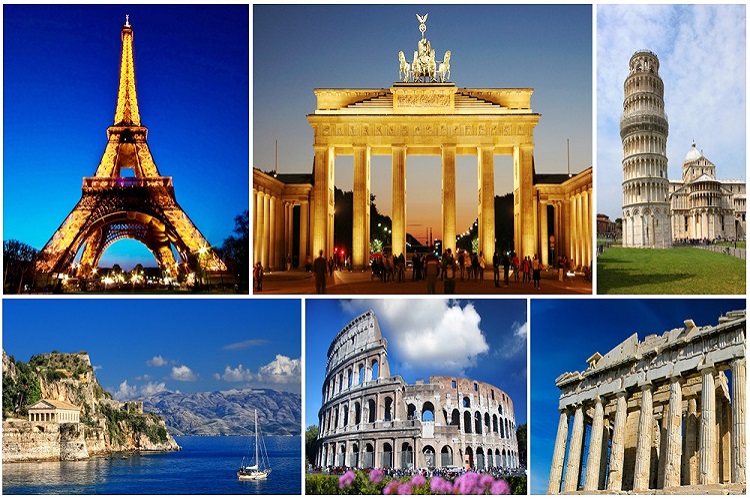Check out these really good deals to Athens from Chicago. CLICK HERE to go roundtrip to Athens for just $582 roundtrip, (staying longer than 6 days) with departures from Feb 2 to May 15th, when the summer prices kick in, but then the prices retreat again on August 10th. So if you are going home to visit relatives or just want to see this awesome country, get your tickets now as these prices will not likely last. Head out to the islands and enjoy life!
Athens is the historical capital of Europe, with a long history, dating from the first settlement in the Neolithic age. In the 5th Century BC (the “Golden Age of Pericles”) – the culmination of Athens’ long, fascinating history – the city’s values and civilization acquired a universal significance. Over the years, a multitude of conquerors occupied Athens, and erected unique, splendid monuments – a rare historical palimpsest. In 1834, it became the capital of the modern Greek state and in two centuries since it has become an attractive modern metropolis with unrivalled charm. A large part of the town’s historic centre has been converted into a 3-kilometre pedestrian zone (the largest in Europe), leading to the major archaeological sites (“archaeological park”), reconstructing – to a large degree – the ancient landscape.
Around Acropolis. The “core” of the historic centre is the Plaka neighborhood (at the eastern side of the Acropolis), which has been inhabited without interruption since antiquity. When you walk through the narrow labyrinthine streets lined with houses and mansions from the time of the Turkish occupation and the Neoclassical period (19th c.), you will have the impression of travelling with a “time machine”. You will encounter ancient monuments, such as the Lysikrates Monument, erected by a wealthy donor of theatrical performances, the Roman Agora with the famed “Tower of the Winds” (1st c. B.C.) and Hadrian’s Library (132 A.D.), scores of bigger and smaller churches, true masterpieces of Byzantine art and architecture, as well as remnants of the Ottoman period (Fetihie Mosque, Tzistaraki Mosque, the Turkish Bath near the Tower of the Winds, the Muslim Seminary, et al.). There are also some interesting museums (Folk Art, Greek Children’s Art, Popular Musical Instruments, Frysira Art Gallery, etc.), lots of picturesque tavernas, cafés, bars, as well as shops selling souvenirs and traditional Greek products.
First, our favorite sites includes the temple of Olympian Zeus (6th c. B.C.), one of the largest in antiquity and close by Hadrian’s Arch (131 A.D.), which forms the symbolic entrance to the city. From there, walking along Dionysou Areopaghitou Street (on the south side of the Acropolis) you pass the ancient Theatre of Dionysos (5th c. B.C.) where most of the works by Sophocles, Euripides, Aeschylos and Aristophanes were performed. Continuing, you will reach the ruins of the Asklepieion (5th c. B.C.) and the Stoa of Eumenes (2th c. B.C.) and from there the Odeion of Herodes Atticus, which was built in 161 A.D. and is nowadays the venue of the performances of the Athens Festival. From there you climb up to the sacred rock of the Acropolis, the site of some of the most important masterpieces of worldwide architecture and art, the most renowned of which is the Parthenon temple. Apart from this, also impressive are the Propylaea, the temple of the Athene Nike and the Erechtheion, while you must not skip a visit to the Museum, located close to the Parthenon. Moreover, from the rock you have an impressive view of the city. Only 300m away from the sacred rock of Acropolis stands the impressive Acropolis Museum, one of the most important contemporary works of architecture in Athens. It is made of steel, glass and concrete and it houses 4,000 priceless finds from the Acropolis monuments that represent its history and function as the most important religious centre of ancient Athens.
Downtown
Syntagma and Omonia are the main central squares of the town; they are linked by Stadiou Street and Panepistimiou Avenue, along which some of the town’s most beautiful Neoclassical buildings have been erected. Dominating Syntagma Squareis the Greek Parliament building and in front of it the Monument of the Unknown Soldier, guarded by the Evzones in traditional costume. From this square starts the beautiful National Garden (40 acres), south of which stands the impressive Zappeion Mansion (1874-1888). From there you can continue towards the Presidential Mansion (1897) and thence to the Panathenaikon (Kallimarmaro) Stadium, where the first Olympic Games in modern history were held (1896). From there, crossing the Mets neighborhood, the road leads you to the First Cemetery, the oldest one in Athens, basically an outdoor sculpture display with a wealth of wonderful monumental tombstones by some of the most important sculptors of the 19th and 20th centuries.






 http://amazingcheapflights.com/follow-us/
http://amazingcheapflights.com/follow-us/